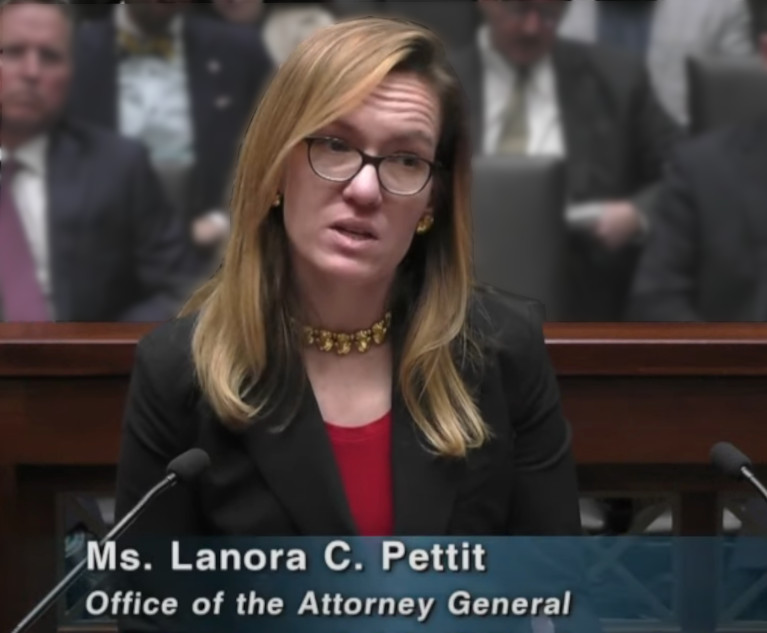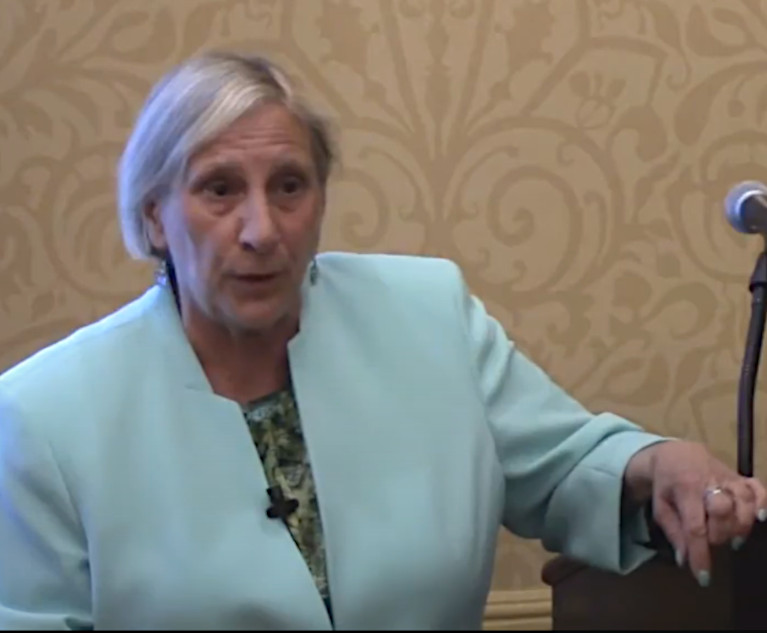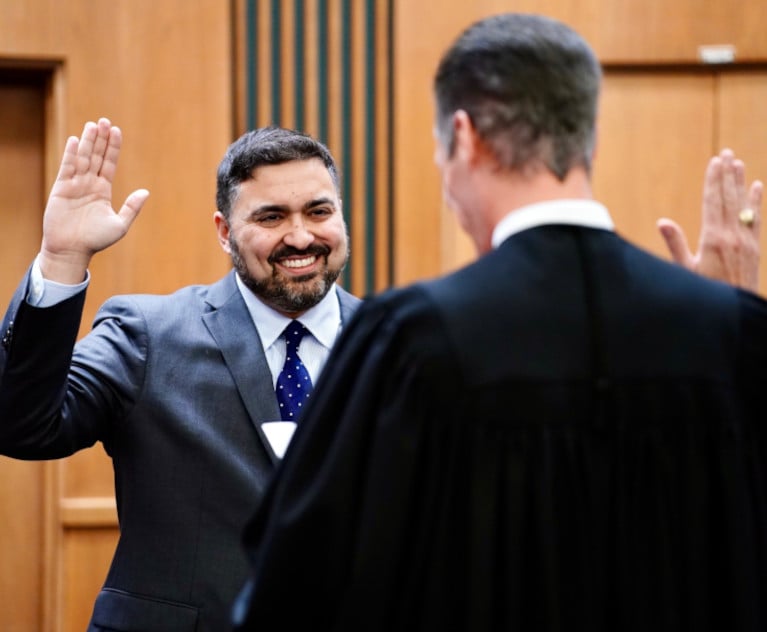Remembering a Judicial Pioneer: Ted Z. Robertson
Texas says goodbye to Ted Z. Robertson, one of the state's last Democratic high court justices.
December 01, 2017 at 12:06 AM
6 minute read
 Ted Z. Robertson in his office at the Supreme Court of Texas, 1985. Photo: Archives Department/State Bar of Texas/Texas Bar Journal
Ted Z. Robertson in his office at the Supreme Court of Texas, 1985. Photo: Archives Department/State Bar of Texas/Texas Bar Journal
Most active lawyers in Texas can't even remember a time when a Democrat sat on the Texas Supreme Court.
Yet last month the Bar bid farewell to Ted Z. Robertson, a former Texas Supreme Court justice who served on the high court from 1982 until 1988—at a time when Democrats held nearly every seat on the court. Robertson, who was one of the most influential justices from that era, died at his Dallas home at age 96.
Robertson is credited among Texas appellate lawyers with leading the high court into the modern age of discretionary review. But his defeat at the ballot box 30 years ago signaled an end to Democrats' control of the high court.
Born in San Antonio in 1921, Robertson's family traced its roots back to the state's earliest settlers. His great-great grandfather, Sterling Clack Robertson, fought at the Battle of San Jacinto, signed both the Texas Declaration of Independence and the Constitution of the Republican of Texas and served as a senator in the Congress of the Republic of Texas.
Robertson earned his law degree from St. Mary's University after serving in the U.S. Coast Guard during World War II, surviving a Japanese torpedo attack that disabled his ship.
After law school, Robertson was in private practice in both San Antonio and Dallas until 1960 when he was hired to head the Dallas County District Attorney's Office civil division. He was later appointed to a Dallas County probate court in 1965, moved to a Dallas County juvenile court in 1969, was appointed to the 95th District Court in 1975 and to the Dallas's Fifth Court of Appeals later that same year.
And in 1982 Robertson was elected to the Texas Supreme Court where he would advocate for the high court's eventual shift from its writ-of-error system of reviewing cases to its current discretionary review system in which the court chooses cases based on their importance to Texas jurisprudence.
“At that point there wasn't discretionary review. We had to read every petition. And the justices had to read them and they had to address them in some way,” said James “Jamie” Parker, a San Antonio appellate lawyer who served as law clerk for Robertson from 1986 until 1987. “It was a long and important battle for the court to have what's essentially a certiorari-type system.”
Robertson wrote a law review article in 1985 about why the writ-of-error system was an inefficient use of the court's time. And the Texas Legislature heeded Robertson's suggestions and saw fit to change the court's case selection method by law in 1987.
George Tex Quesada, a Dallas attorney who also served a law clerk on the court in the mid-1980s, said Robertson served on a Texas Supreme Court that focused on affirming jury verdicts—something far different than the current court is known for.
“He was a very practical judge,” said Quesada, who would later practice law with Robertson in Dallas after he left the bench. “He didn't appear to be agenda-driven and he had a heart for the working person.”
One of Robertson's favorite stories was how came to be rescued from the U.S.S. Etamin, a Coast Guard support ship he was serving aboard when it was blown up by a Japanese torpedo in 1944, Quesada said.
“He said he got recruited to join the U.S. Coast Guard and he was told he'd probably spend the war in Corpus Christi. And he ends up getting torpedoed off the coast of New Guinea,” Quesada said.
Robertson and other sailors jumped from the disabled ship and were stranded at sea for days in a lifeboat as U.S. military battled the Japanese on the island. And there was a reason for their delayed rescue, Quesada said.
“He told me they waited out in the bay to see who was winning—they wanted to see who won the battle first,” Quesada said. “Now that's practicality.”
In 1987, Robertson decided to run for the chief justice spot when John Hill retired. But that same year, Robertson was mentioned in a CBS News “60 Minutes” report called “Justice for Sale?” which focused on the influence that plaintiffs attorneys and wealthy litigants had on three of the Democratic justices on the court.
Robertson was later defeated in the general election by Tom Phillips, who was appointed to the court by Republican Gov. Bill Clements in 1988. Phillips featured the “60 Minutes” report heavily in campaign ads—one of the most expensive races in the court's history—and beat Robertson soundly with 56 percent of the vote in the 1988 general election. That year, Phillips, along with Nathan Hecht and Eugene Cook, became the first Republicans since Reconstruction to be elected to the court.
“He was very gracious,” Phillips said of Robertson. “He called me the night of the election and told me he wanted to be known as 'Tom Phillips' No. 1 fan' henceforth.”
Republicans were emboldened by the election and by 1996, they had taken all nine of its seats. Robertson, who had sat on every level of court in the state, said in a 1987 that he considered winning the chief justice spot the “golden ring” of the state judiciary and it was a shot he had to take. But during his tenure on the court, Robertson traveled to Austin during the week and then returned home on the weekends to Dallas to care for his ailing wife. She died after the 1988 campaign.
“When I was clerking his wife was very ill,” Parker said. “It would have been great if he would have been able to become the chief. But it was OK that he didn't too.”
This content has been archived. It is available through our partners, LexisNexis® and Bloomberg Law.
To view this content, please continue to their sites.
Not a Lexis Subscriber?
Subscribe Now
Not a Bloomberg Law Subscriber?
Subscribe Now
NOT FOR REPRINT
© 2025 ALM Global, LLC, All Rights Reserved. Request academic re-use from www.copyright.com. All other uses, submit a request to [email protected]. For more information visit Asset & Logo Licensing.
You Might Like
View All

HUD Charges Texas HOA With Housing Discrimination in Last Days of Biden Administration
5 minute read
Trending Stories
- 1Uber Files RICO Suit Against Plaintiff-Side Firms Alleging Fraudulent Injury Claims
- 2The Law Firm Disrupted: Scrutinizing the Elephant More Than the Mouse
- 3Inherent Diminished Value Damages Unavailable to 3rd-Party Claimants, Court Says
- 4Pa. Defense Firm Sued by Client Over Ex-Eagles Player's $43.5M Med Mal Win
- 5Losses Mount at Morris Manning, but Departing Ex-Chair Stays Bullish About His Old Firm's Future
Who Got The Work
J. Brugh Lower of Gibbons has entered an appearance for industrial equipment supplier Devco Corporation in a pending trademark infringement lawsuit. The suit, accusing the defendant of selling knock-off Graco products, was filed Dec. 18 in New Jersey District Court by Rivkin Radler on behalf of Graco Inc. and Graco Minnesota. The case, assigned to U.S. District Judge Zahid N. Quraishi, is 3:24-cv-11294, Graco Inc. et al v. Devco Corporation.
Who Got The Work
Rebecca Maller-Stein and Kent A. Yalowitz of Arnold & Porter Kaye Scholer have entered their appearances for Hanaco Venture Capital and its executives, Lior Prosor and David Frankel, in a pending securities lawsuit. The action, filed on Dec. 24 in New York Southern District Court by Zell, Aron & Co. on behalf of Goldeneye Advisors, accuses the defendants of negligently and fraudulently managing the plaintiff's $1 million investment. The case, assigned to U.S. District Judge Vernon S. Broderick, is 1:24-cv-09918, Goldeneye Advisors, LLC v. Hanaco Venture Capital, Ltd. et al.
Who Got The Work
Attorneys from A&O Shearman has stepped in as defense counsel for Toronto-Dominion Bank and other defendants in a pending securities class action. The suit, filed Dec. 11 in New York Southern District Court by Bleichmar Fonti & Auld, accuses the defendants of concealing the bank's 'pervasive' deficiencies in regards to its compliance with the Bank Secrecy Act and the quality of its anti-money laundering controls. The case, assigned to U.S. District Judge Arun Subramanian, is 1:24-cv-09445, Gonzalez v. The Toronto-Dominion Bank et al.
Who Got The Work
Crown Castle International, a Pennsylvania company providing shared communications infrastructure, has turned to Luke D. Wolf of Gordon Rees Scully Mansukhani to fend off a pending breach-of-contract lawsuit. The court action, filed Nov. 25 in Michigan Eastern District Court by Hooper Hathaway PC on behalf of The Town Residences LLC, accuses Crown Castle of failing to transfer approximately $30,000 in utility payments from T-Mobile in breach of a roof-top lease and assignment agreement. The case, assigned to U.S. District Judge Susan K. Declercq, is 2:24-cv-13131, The Town Residences LLC v. T-Mobile US, Inc. et al.
Who Got The Work
Wilfred P. Coronato and Daniel M. Schwartz of McCarter & English have stepped in as defense counsel to Electrolux Home Products Inc. in a pending product liability lawsuit. The court action, filed Nov. 26 in New York Eastern District Court by Poulos Lopiccolo PC and Nagel Rice LLP on behalf of David Stern, alleges that the defendant's refrigerators’ drawers and shelving repeatedly break and fall apart within months after purchase. The case, assigned to U.S. District Judge Joan M. Azrack, is 2:24-cv-08204, Stern v. Electrolux Home Products, Inc.
Featured Firms
Law Offices of Gary Martin Hays & Associates, P.C.
(470) 294-1674
Law Offices of Mark E. Salomone
(857) 444-6468
Smith & Hassler
(713) 739-1250







